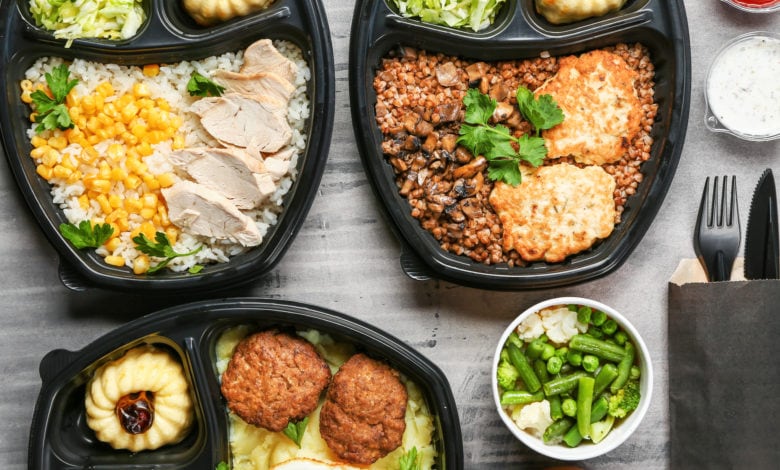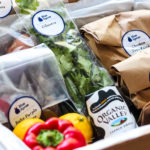Are Meal Kits More Eco-Friendly Than Groceries?

If you’ve ever felt guilty because of using a meal delivery kit or subscription service, imagining this is a huge drain on environmental resources, you may be surprised to discover that despite the use of plastics and packaging involved, in comparison to the entire food lifecycle, using these kits may actually generate much less food waste than traditional grocery shopping.
This decrease in food waste throughout the supply chain and entire lifecycle ends up being of much more importance than the use of plastic and packaging involved with meal kit options like Sun Basket and Home Chef.
Have you ever gone grocery shopping for the week or month and realized at a certain point you need to throw away a certain amount of food? If you’ve ever felt guilt over this, or guilt over the use of a meal kit delivery service for other environmental waste, you may be surprised by the greater carbon footprint culprit.
Typical store-purchased food waste, along with all of the grocery store double-bag plastic options most of us use, actually contributes to a large bulk of environmental damage than plastics and packaging in food kits and boxes.
With meal kits, although there are plastics and packaging involved, there is much less waste generated throughout the process from start to finish- and you typically finish all of your meals without any disposal.
But you’ve probably never even considered the environmental effects of food waste during production and distribution.
A recent study on food waste and environmental food choices actually suggests that store meals from your local grocery chain produce about 33% more greenhouse gas emissions than popular meal delivery kit options like Blue Apron or Sun Basket.
Are Meal Kits More Eco-Friendly Than Groceries?: Environmental Impacts & Waste
Food production in general has an enormous carbon footprint, and is responsible for almost 30% of greenhouse gas emissions. Food waste occurs during the entire lifecycle, including production and distribution. Plastics used to keep food fresh do contribute to waste, but chemical pesticides, fertilizers, processes during farming, and equipment are all considerations.
The study on meal kits in comparison to grocery shopping postulates that because a set amount of food is being delivered, a larger use of plastics (and subsequent carbon footprint) could actually be less harmful than food waste from the use of traditional grocers- or even takeout food or dining out options, unless you always save every bite and take food home with you.
Based on USDA consumer food habits and trends, we generally waste quite a bit of food. Whether its the fresh produce you’ve purchased on a health kick, or a large savings pack of food on a discount that you end up never eating, we are definitely disposing of large quantities of food on a regular basis.
So researchers decided to try experimenting with different meal delivery subscription kits and account for how much waste was created in comparison to these USDA based findings.
Not only did researchers find they consumed all of the food provided in meal kits (contributing no bulk waste), they took into account waste during production and manufacturing processes as well for comparison.
Are Meal Kits More Eco-Friendly Than Groceries?: Production and Distribution
In taking into account waste for the entire food lifecycle (groceries vs. meal kits), researchers also found that greenhouse gas emissions were lower for food kits during production and distribution phases.
Because it’s difficult for grocery stores to anticipate demand, and because they often have to toss food that ends up not being sold (contributing to further waste), they always buy more than they can sell even though they still yield profits.
Meal delivery subscription services operate on a different direct to consumer business model, which cuts down on food waste during distribution phases. In terms of shipping emissions, meal kits were at 4% in comparison to grocery stores at 11%.
So while it may seem extra plastics and cardboards used in meal kits are more detrimental to the environment, having food go bad in your fridge or in shelves on a regular basis is actually leaving a more lasting and damaging carbon footprint. Plus the way that food was distributed to the grocer also leads to an incredible amount of food waste, if it isn’t donated in a timely manner (and typically stores will try bargain sales for weeks prior to a simple discard).
But even from a purely distribution perspective, it seems even if you’re never tossing any food away, the impact on grocery waste due to supply and demand factors simply outweighs the costs of the direct to consumer model (along with no consumer waste) that meal kits provide. Making them a seemingly more eco-friendly option even if you are vigilant about food composting or never wasting food.
Are Meal Kits More Eco-Friendly Than Groceries?: The Final Verdict
While meal kits still have their flaws, such as freezer packs (which can be quite the hassle and confusion to recycle), and come with plastics and cardboards, in terms of the entire food lifecycle, it appears that there is a major eco-friendly advantage to using these services in addition to delicious pre-packaged and counted meals (where you can also track your calories, carbs, or any desired food metric/group), and the added convenience factor.
So instead of feeling guilty the next time your gluten-free or Paleo plan specific diet option arrives from your meal kit of choice, perhaps it is best to think about the food you didn’t waste by not realizing it wasn’t a part of the plan at the grocery store.
But the driving-home point here remains, that if you study the entire lifecycle process and supply chain of food and waste from production to your plate, their are major costs and wastes that go into the process.
While these wastes accrue with both popular meal delivery kit service options and traditional grocery store shopping, it seems that they stack up at higher rates with traditional shopping due to wastes and production costs from start to finish.
Most of us don’t realize how costly food manufacturing and distribution is, and most of us realize the plastics and components involved with meal boxes.
But even if we take responsibility for tossing a leftover family-value pack of food or produce that has gone bad, we fail to realize how often large-scale grocery stores order and throw out pounds of food per day, week, and year due to questionable demand.
So you can enjoy eating all of your favorite dishes from your meal kit service of choice free of any eco-guilt, knowing a direct to consumer model saves on millions in food waste and its subsequent carbon footprint.
Beverly joined MFS with a diverse breadth of experience in writing and digital marketing. Throughout the years of placing recipes on MFS, I’ve noticed an uptick in the number of “subscription boxes” for the cooking/food market. It was then that I decided to also include my own personal review of these subscriptions on MFS.





